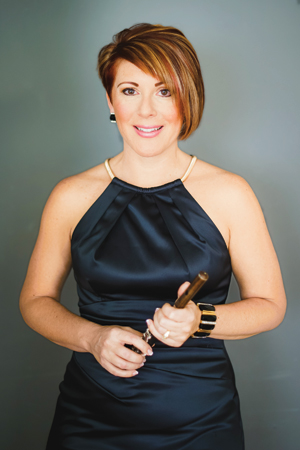
Christine Erlander Beard is an international performer and the professor of flute at the University of Nebraska at Omaha. She is also the founder and artistic director of the International Piccolo Symposium.
Where do you place your cork?
I used to align my cork just slightly right of center to help with the intonation of the lower register; but I am finding that I no longer need to do this with my new headjoint.
How do you align the headjoint with the body?
I align the embouchure hole rolled out (away) from the keys, maybe an 1/8 of an inch, which helps me to keep an open and singing tone.
How do you care for your wooden piccolo?
Here in Nebraska, the winters get extremely dry with humidity levels dropping into the single digits. Fortunately, I have not had any problems with my modern piccolos cracking despite that fact that I do not go to extra measures to oil them. The pads, on the other hand, give me a lot of trouble during the wet spring and summer months as I am constantly having to use pad paper to avoid the smacking sound of sticky pads. (I prefer to use powdered paper because I find it to be more effective.)
Do you wear ear plugs?
I don’t like to wear earplugs and don’t often wear them, unless I am doing extended practice in the upper register. Even then, I will only wear one – in my left ear – so that I can hear my true tone and dynamic level. The same is true when I am playing in orchestra. Despite having said this, I encourage my students to wear earplugs. I am fortunate not to have suffered (too much) hearing damage, but it is very easy to do if you are not careful. This is definitely one of those “Do as I say and not as I do” issues.
What alternate fingerings do you use on a regular basis?
I have many that I use. I especially like to use alternate fingerings for sustaining notes at a soft dynamic level: 2nd octave Bb (Th-1-3 | 1-2-3-4), Bn (Th-1-3|1-2-4), Cn (1-2-3-4 | 1-4) and C# (2-3 | 2-3-4) are the ones that come to mind immediately. I often vent An in the 2nd octave (Th-1-2-4 | 4) to give it a more resonate tone. I also love the sharp fingering for 3rd octave F# (Th-1-3 | 2-3) because it blows more freely. Whenever possible, I use the alternate for 3rd octave Ab (2-3-4 | 2-3-4) because it speaks more easily. Most of the alternate fingerings I use help to bring the pitch up – which I personally find much
more difficult than bringing the pitch down.
How do you warm up?
My warmup routine on both piccolo and flute consists mostly of scale exercises by Taffanel et Gaubert (EJ1 and EJ4), incorporating singing while playing to help relax my throat and make my tone more open. On both instruments, I find that warming up in the low register and working to focus the tone in the first octave helps me to achieve a more relaxed and beautiful tone in the upper registers. I also like using short melodies transposed in sequence to various keys, and octave slurs for tone as well as for checking intonation.
What are your thoughts on vibrato when playing the piccolo vs. the flute?
I like to use a lot of different speeds and depths of vibrato in both my flute and piccolo playing depending on the style, dynamic level, and era in which the piece was written. That being said, I typically prefer to use a fast yet deep, spinning vibrato in the upper register to create drama and dimension in the tone and to avoid a piercing quality you often get with a narrow or straight tone approach. Envision the sound waves in the upper register: in the 3rd octave of the piccolo (sounding four octaves above middle C on the piano) they are quite fast and narrow. The vibrato on a note in this octave has to be enough different from the note’s sound wave to differentiate the vibrato from the sound wave. In other words, if the vibrato is too shallow, it cannot be heard because it is cancelled out by the sound wave. This is, of course, a very general statement and merely one example of a single scenario; nonetheless, it is an important factor to consider when thinking about vibrato production on piccolo. On a somewhat related note, I do not believe in a natural vibrato on either flute or piccolo. I feel very strongly that players should be able to control all the various aspects of vibrato and be able to change it in order to obtain a beautiful vibrato that not only sings, but is also capable of creating contrast and variation in color and sound.
Do you single tongue most things or do you double tongue?
Whether I double tongue or single tongue is completely dependent on how well I am able to maintain the tone I want through a passage, and how well I am able to preserve a consistent articulation. In the case of the latter, I often find it is better for me to single tongue repeated notes (on the same pitch), whereas I will more often use double tongue for changing notes. For triple tonguing, I always use an alternating double tongue on both flute and piccolo (TKT/KTK). In most cases, whether single, double or triple tonguing, I more often use the softer syllables (Du, Gu) over the more traditional harder syllables (Tu, Ku). For soft attacks at the beginning of a phrase, I almost always use poo rather than the tongue, or sometimes even just start the note with the air. Of course, my approach will change depending on the acoustics of the space as well as the style of the piece or effect I am trying to achieve.
What are the solos a piccolo player should know?
• Piccolo Play for piccolo and piano by Thea Musgrave
• Concerto for Piccolo, Op. 50 by Lowell Liebermann
• Lachrymose for solo piccolo by Derek Charke
• Sonata, Op.61 for piccolo and piano by John LaMontaine
• Sonatine de Giverny for piccolo and piano by Daniel Dorff
• To the Nth Degree (Sonata No. 3) for piccolo and piano by Matthew Smith
• Souvenirs for piccolo and piano by Robert Beaser
• Kay El’lem for piccolo and piano by Jan Hulyebroeck
• Timeless for piccolo and piano by Ken Benshoof
• The High and the Mighty for piccolo and piano by Michael Daugherty
• Concerto for Piccolo by Bruce Broughton
The Vivaldi Concerti have been omitted from this list because it is expected that all piccolo players learn to play these pieces. The list includes both works that are now considered standard piccolo repertoire plus a couple of lesser-known pieces that I feel add a new dimension (both technically and musically) that is not represented by the standard pieces.
Which piccolo players have influenced your playing?
It is hard to narrow the list down to only a few. First and foremost, I have to acknowledge Jean-Louis Beaumadier for opening up many opportunities for me; I do not think I would be where I am today without his mentoring and friendship. I admire the ease with which he plays and adore the character he personifies while on stage. Horacio Massone, (formerly piccoloist but now principal flute in the Orquesta Teatro Argentino de La Plata) is a good friend who has had a major influence on my concept of piccolo tone and has really inspired me to achieve a more focused, rich sound in the lower register. Peter Verhoyen is an amazing teacher who plays with wonderful expression, and I love how he always appears to have a lot of fun while performing. I also have tremendous respect his work in commissioning composers to write more music for the piccolo and his enthusiasm for bringing piccoloists together for various projects. Nicola Mazzanti has the most amazing dynamic control of any piccoloist on the planet, and he is my role model for soft playing in the extreme third octave. I also have to mention that my one and only piccolo lesson came after hearing Zart Eby in recital at the Texas Flute Festival in 2000 while I was still a doctoral student at UT/Austin. Soon after, I flew to Seattle to have lessons with her over a weekend. I had never heard a real solo piccolo player in concert before, and both her energy and spinning tone were magical to me. Though brief, those experiences with her really solidified my desire to become a piccolo specialist. Performers never know when they might make a huge impact on a young person in an audience. Zart had that effect on me, and I can only hope that I am also inspiring young piccolo players to follow their passion and create a niche for themselves.
Christine Erlander Beard is a soloist, chamber artist and teacher and has performed extensively around the world, including at thirteen N.F.A. conventions and three British Flute Society International Conventions. She performed with French piccolo legend Jean-Louis Beaumadier on his newest CD, Postcards: World Piccolo, Vol. 2. Her debut solo CD, To the Nth Degree will be released in 2017. A member of the NFA’s piccolo committee since 2015, she has commissioned and premiered dozens of new works from composers across the globe. In 2007 she founded the International Piccolo Symposium, a four-day workshop held at the University of Nebraska at Omaha. Beard earned her MM and DMA in flute performance from The University of Texas at Austin where she was a student of Karl Kraber. She joined the faculty at the University of Nebraska at Omaha in 2002 where she teaches flute, woodwind pedagogy, chamber music, contemporary music literature, and heads the contemporary music program as the director of Ensemble 768. www.christiebeard.com





